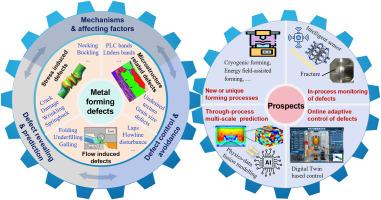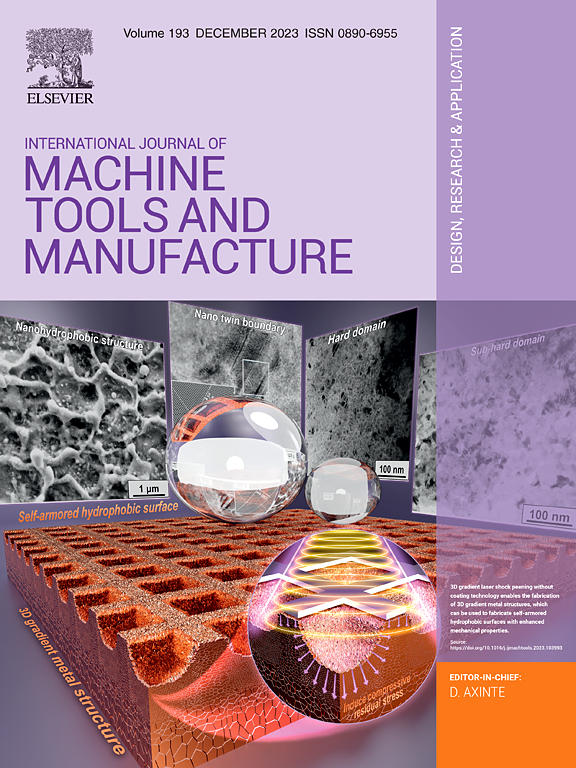金属成形缺陷:形成机制、预测与避免
IF 18.8
1区 工程技术
Q1 ENGINEERING, MANUFACTURING
International Journal of Machine Tools & Manufacture
Pub Date : 2025-03-19
DOI:10.1016/j.ijmachtools.2025.104268
引用次数: 0
摘要
金属成形中的缺陷产生了许多与产品质量、性能、生产率、生产成本和可持续性相关的瓶颈问题。在基于金属成形的产品开发中,通过预测和避免缺陷形成来有效地解决预先设计过程中的缺陷问题是最关键和最具挑战性的问题。在本文中,对金属成形中的缺陷分类、形成机制、建模/预测以及避免原则和策略的重要见解进行了编排和阐述。首先,列举了金属成形过程中几乎所有的潜在缺陷,并将其分为应力缺陷、流动缺陷和微结构缺陷三大类。针对每一类缺陷,分别阐述了其影响因素、形成机制和分析方法。此外,通过采用不同的最先进技术,包括过程传感/监测/检测、基于数据的建模和在线自适应控制,从缺陷识别、控制、避免或消除方面阐述了对策。最后,对缺陷分析、建模/预测和避免的观点进行了编排和展示,重点关注创新工艺开发、实时过程监控、物理信息和数据驱动的全过程建模,以及智能和可持续制造的策略。本文章由计算机程序翻译,如有差异,请以英文原文为准。

Defects in metal-forming: Formation mechanism, prediction and avoidance
Defects in metal-forming create numerous bottleneck issues related to product quality, properties and performance, productivity, production cost, and sustainability. Effectively addressing defect issues in the up-front design process via prediction and avoidance of defect formation is the most critical and challenging issue in metal-forming based product development. In this paper, vital insights into defect classification, formation mechanisms, modelling/prediction, and avoidance principles and strategies in metal-forming are orchestrated and articulated. First, almost all the potential defects in metal-forming are exemplified and classified into three categories, viz., stress-induced, flow-induced, and microstructure-related defects. For each defect category, its influencing factors, formation mechanisms, and analysis approaches are delineated. Additionally, the countermeasures are articulated from the aspects of defect identification, control, avoidance or elimination by employing different state-of-the-art techniques, including in-process sensing/monitoring/detection, data-based modelling and online adaptive control. Finally, perspective insights into defect analysis, modelling/prediction, and avoidance are orchestrated and presented, focusing on innovative process developments, real-time in-process monitoring, physics-informed and data-driven through-process modelling, and strategies for intelligent and sustainable manufacturing.
求助全文
通过发布文献求助,成功后即可免费获取论文全文。
去求助
来源期刊
CiteScore
25.70
自引率
10.00%
发文量
66
审稿时长
18 days
期刊介绍:
The International Journal of Machine Tools and Manufacture is dedicated to advancing scientific comprehension of the fundamental mechanics involved in processes and machines utilized in the manufacturing of engineering components. While the primary focus is on metals, the journal also explores applications in composites, ceramics, and other structural or functional materials. The coverage includes a diverse range of topics:
- Essential mechanics of processes involving material removal, accretion, and deformation, encompassing solid, semi-solid, or particulate forms.
- Significant scientific advancements in existing or new processes and machines.
- In-depth characterization of workpiece materials (structure/surfaces) through advanced techniques (e.g., SEM, EDS, TEM, EBSD, AES, Raman spectroscopy) to unveil new phenomenological aspects governing manufacturing processes.
- Tool design, utilization, and comprehensive studies of failure mechanisms.
- Innovative concepts of machine tools, fixtures, and tool holders supported by modeling and demonstrations relevant to manufacturing processes within the journal's scope.
- Novel scientific contributions exploring interactions between the machine tool, control system, software design, and processes.
- Studies elucidating specific mechanisms governing niche processes (e.g., ultra-high precision, nano/atomic level manufacturing with either mechanical or non-mechanical "tools").
- Innovative approaches, underpinned by thorough scientific analysis, addressing emerging or breakthrough processes (e.g., bio-inspired manufacturing) and/or applications (e.g., ultra-high precision optics).

 求助内容:
求助内容: 应助结果提醒方式:
应助结果提醒方式:


